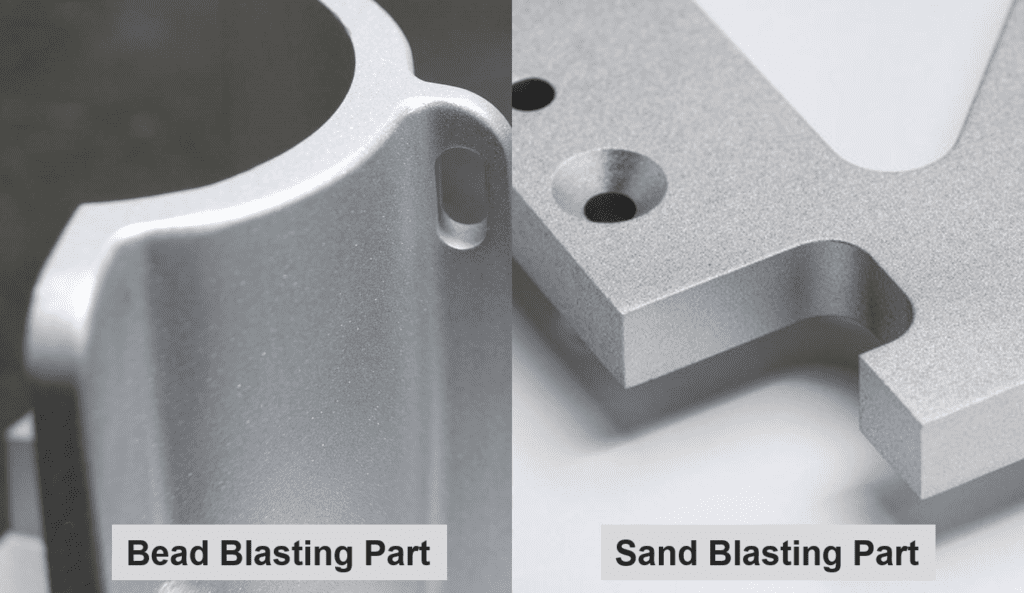
制造的部件需要进行表面精加工操作才能获得特定的表面特性和美观度。喷珠和喷砂是用于 CNC 加工、铸造和装配部件的两种常见精加工操作。尽管喷珠和喷砂的性质相似且遵循相同的工作原理,但它们之间的区别可以在喷砂介质、工艺、应用和总体结果中看出。喷珠打捞通常提供一种适合精细材料的温和方法,而喷砂通常是严格清洁和除锈的首选。
此外,本文将详细阐述喷丸和喷砂的区别,以帮助您根据具体要求做出明智的决定。
什么是喷砂?
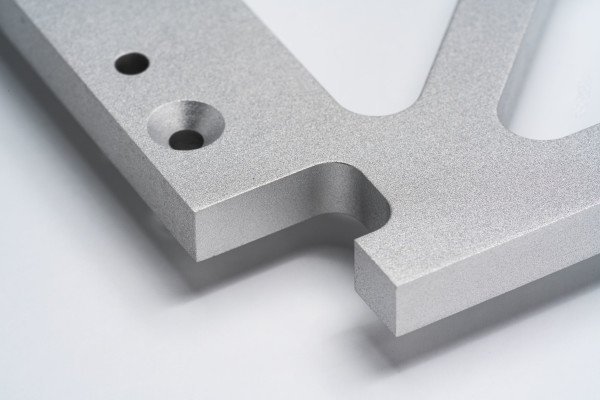
铝部件经过喷砂处理
喷砂工艺涉及使用磨料钢、陶瓷或玻璃珠去除表面的细小物质,并形成光滑闪亮的表面。该方法使用喷枪以高压(20-70 psi)向零件发射喷砂珠。
当在受控压力下将珠子推进表面时,其研磨作用会产生多种效果,包括清洁表面的污垢和尘垢、去除旧漆或涂层,以及形成均匀光滑的表面。
喷砂的温和性质以及喷珠的形状和材质使其有别于喷砂等更具侵蚀性的方法。
表 1:常见珠子类型和尺寸
| 材料 | 尺寸(微米) | 应用 |
|---|---|---|
| 玻璃 | 50-200 | 汽车、航空航天 |
| 陶瓷制品 | 100-300 | 精致材质,精细抛光 |
喷丸处理是如何进行的?
如上所述,该工艺涉及以高压向加工部件喷射钢珠或碎玻璃。喷砂介质在部件上形成压痕,然后形成均匀的表面。
最终结果是缎面或暗淡的外观,根据所用喷砂介质的粗糙度,可能看起来粗糙一致或更光滑。喷砂方法的一大优点是它有助于隐藏零件上的任何机器痕迹或瑕疵。这是因为它只会产生比零件原始颜色更亮的颜色,从而掩盖其表面上的任何差异。
喷砂技术与设备
喷砂需要专门的设备来处理喷砂珠的尺寸、形状和材料,以及喷砂的压力和角度。常用的设备包括用于小部件的喷砂柜、用于较大部件的喷砂室以及控制喷砂压力的压力喷砂系统。
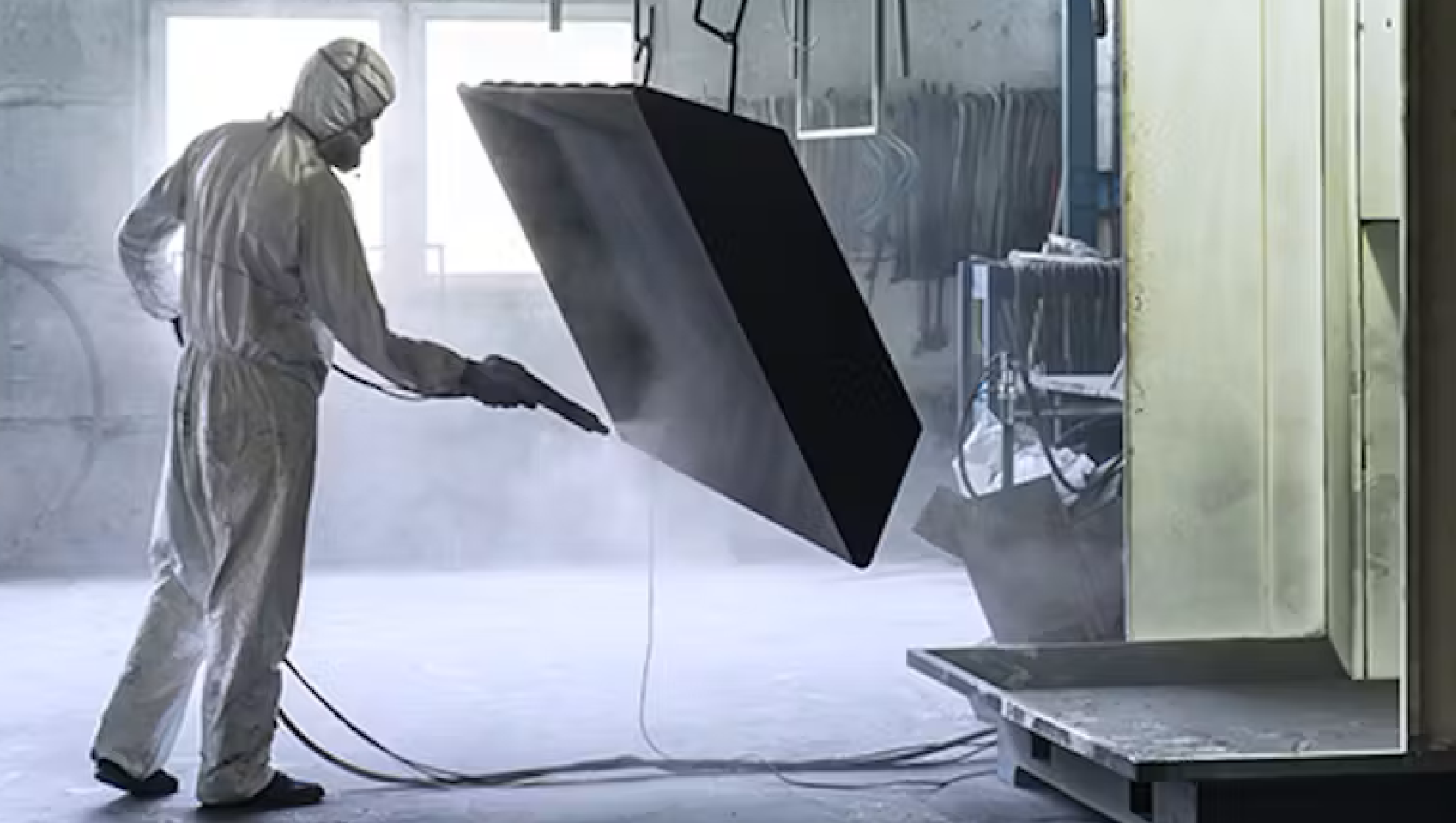
因此,必须选择正确的喷砂参数(如设备类型、喷砂压力和喷砂珠尺寸),以实现所需的表面光洁度,而不会过度磨损或变形。
表 2:喷砂设备规格
| 设备类型 | 压力范围 (PSI) | 介质容量(磅) | 典型应用 |
|---|---|---|---|
| 喷砂柜 | 40-130 | 25-100 | 小部件、精细材料 |
| 爆炸室 | 50-150 | 100-1000 | 大型部件,工业 |
| 压力喷砂系统 | 60-150 | 50-500 | 用途广泛 |
应用和用途
喷丸处理是一种用途广泛的技术,可用于多个领域,包括航空航天工业(用于清洁和打磨精密部件而不影响其结构完整性)、汽车工业(用于通过去除油漆和氧化物来恢复旧汽车零件)和家具修复(用于轻轻去除古董家具上的旧漆和饰面,从而保留木材的自然美)。
- 它能提供光滑的表面且不会造成深度磨损。
- 适用于清洁复杂且精密的部件。
- 可以利用再生玻璃珠等环保材料。
什么是喷砂?
喷砂,也称为磨料喷砂,涉及将细小的颗粒状介质以高速喷向表面。传统上,首选磨料是沙子,但现在根据应用和表面要求,也会使用各种其他材料。
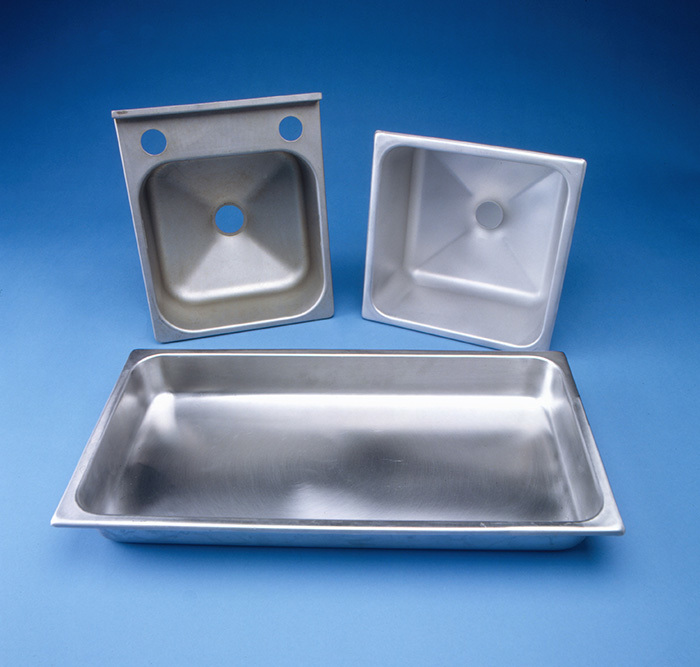
不锈钢喷砂处理
喷砂是一种用途广泛的技术,可用于除锈、除腐蚀、清除污染物、油脂、准备表面以进行涂漆或涂层处理以及对表面进行纹理处理以增强附着力。它可以处理大面积和粗糙的表面,并适用于不同的材料和饰面。
表 3:常见喷砂介质类型和砂粒大小
| 材料 | 粒度范围 | 应用 |
|---|---|---|
| 沙 | 16-220 | 常规清洁、除锈 |
| 碳化硅 | 20-220 | 强力切割、玻璃蚀刻 |
| 氧化铝 | 16-220 | 除漆,表面处理 |
| 钢砂 | G10-G120 | 快速切割,深轮廓 |
喷砂是如何进行的?
喷砂处理也遵循与喷砂相同的原理,使用高压和喷砂柜来防止暴露。该过程也在喷砂柜中进行,使用的砂介质有时可重复使用。它适用于去除旧部件的油漆或锈迹或为新表面处理做准备。然而,喷砂通常对金属表面更苛刻,可能会影响部件的尺寸。
喷砂技术与设备
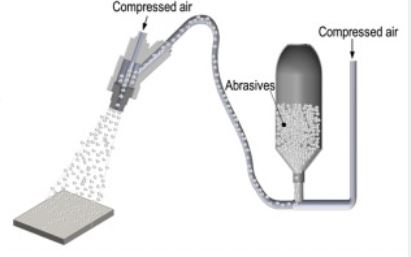
喷砂工艺
喷砂技术和设备必须经过仔细选择,以满足应用要求。主要考虑因素包括磨料的类型、尺寸、硬度、喷砂压力、喷嘴尺寸和表面状况。
表 4:喷砂设备规格
| 设备类型 | 压力范围 (PSI) | 介质容量(磅) | 典型应用 |
|---|---|---|---|
| 虹吸喷射系统 | 30-100 | 50-300 | 轻度清洁,细节工作 |
| 直接压力系统 | 50-150 | 100-1000 | 除锈、表面处理 |
| 自动喷砂系统 | 60-180 | 200-2000 | 高精度、工业规模 |
应用和用途
在汽车行业,喷砂用于去除车身上的铁锈、油漆和氧化物,为重新上漆做准备。在建筑行业,喷砂可以清洁和修复砖块、石头和混凝土等表面,有效去除旧漆和污垢。在金属加工中,在焊接或涂层之前准备表面是必不可少的,以确保更好的附着力和干净的表面。对于机加工零件,它可以去除毛刺、加工痕迹和其他轻微的表面缺陷。
- 创建均匀的表面纹理。
- 非常适合清洁和准备后续工序,如阳极氧化或喷漆。
- 可以使用环保型磨料,如再生玻璃或核桃壳。
What are the Key Differences between Sand and Beadblasting?
The decision to choose between glass bead blast and sandblasting often comes down to understanding the unique aspects, requirements, and results of each method. Here’s a detailed comparison:
Sandblasting uses sharp-edged sand particles(sand, silicon carbide, and aluminum oxide) to aggressively clean and etch surfaces, making it suitable for heavy-duty tasks. On the other hand, bead blasting uses spherical glass or ceramic beads, which provide a softer abrasive action. It is ideal for delicate and intricate components.
Table 5: Comparison of Materials and Hardness
| Method | Typical Materials | Mohs Hardness | Application |
|---|---|---|---|
| Bead Blasting | Glass, Ceramic | 5-6 | Delicate surfaces, Polishing |
| Sandblasting | Sand, Silicon Carbide | 6-9 | Rust removal, Rough surfaces |
Next, let’s compare beadblasting vs sandblasting in different aspects.
1. Techniques and Equipment
The equipment for bead blasting and sandblasting varies, reflecting differences in pressure, nozzle design, and media size.
Table 6: Comparison of Techniques and Equipment
| Aspect | Bead Blasting | Sandblasting |
|---|---|---|
| Nozzle Type | Wide | Narrow |
| Pressure | Moderate (40-150 PSI) | High (50-180 PSI) |
| Media Size | Small (50-300 Microns) | Varied (16-220 Grit) |
2. Environmental Impact and Safety
Bead blasting, despite being a gentler process, still has environmental impacts that need to be considered. Possible water contamination, energy consumption, and waste management are all factors that need to be considered when utilizing this method for surface finishing. Proper protocols must be in place to ensure that bead blasting is performed in an environmentally responsible manner.
Sandblasting is a method that uses abrasive materials, which requires careful handling of environmental concerns. The process can produce airborne dust and pollution, high noise levels, and consume resources.
Environmental considerations include proper disposal of spent media, ensuring adequate ventilation and dust control for air quality, and providing appropriate personal protective equipment (PPE) for operator safety.
3. Cost and Efficiency
Cost and efficiency may also factor into the decision-making process, with sandblasting often being more cost-effective but potentially more aggressive.
Table 7: Cost and Efficiency Comparison
| Aspect | Bead Blasting | Sandblasting |
|---|---|---|
| Average Cost | Higher | Lower |
| Efficiency | Moderate | High |
| Surface Finish | Smoother | Rougher |
Try Prolean Now!
Advantages of Bead Blasting and Sandblasting
Both the finishes clean and enhance substrate appearance and adhesion properties. They can remove rust, paint, and other contaminants. Consequently, both methods are versatile and suitable for various materials. However, they also have some specific benefits that differ from each other.
Advantages of Bead Blasting
1. Gentle and Precise
Bead blasting is renowned for its gentle approach, making it suitable for applications that require precision without damaging the underlying material.
- Bulleted List:
- Delicate materials such as aluminum, plastic.
- Fine polishing without deep abrasion.
- Preservation of original contours.
2. Suitable for Delicate Materials
Different industries prefer bead blasting for delicate materials, from automotive parts to aerospace components. Additionally, bead blasting can use environmentally friendly materials, such as recycled glass beads, promoting sustainable practices.
Table 8: Industry-Specific Applications and Materials
| Industry | Materials | Application |
|---|---|---|
| Aerospace | Titanium, Aluminum | Engine parts, Wings |
| Automotive | Chrome, Alloy | Rims, Engine parts |
| Restoration | Wood, Antique metal | Furniture, Artifacts |
3. Versatility in Finishes
Bead blasting offers versatile finishing options, allowing for customized results tailored to specific needs.
Table 9: Bead Blasting Finishes and Applications
| Finish Type | Bead Material | Pressure (PSI) | Applications |
|---|---|---|---|
| Smooth | Glass | 40-80 | Automotive, Glass |
| Matte | Ceramic | 60-120 | Jewelry, Metalwork |
| Textured | Mixed Media | 80-150 | Sculptures, Art |
Advantages of Sandblasting
Sandblasting, owing to its aggressive nature and wide range of media choices, offers a multitude of advantages:
1. Efficiency and Speed
Sandblasting is an efficient method for removing contaminants quickly, making it a preferred choice in various industrial applications. It can rapidly remove rust and paint, clean large surface areas, and requires minimal manual labor, making it a time-saving solution for surface preparation and restoration projects.
2. Versatility in Applications
Sandblasting is a versatile technique used in various industries for many applications. It is commonly used in the automotive industry for paint stripping and rust removal, in maritime applications for hull cleaning, in manufacturing for surface preparation, and in restoration for masonry and wood restoration, among others. Different materials are used for sandblasting, including silicon carbide, steel grit, aluminum oxide, glass beads, and others, depending on the application and surface requirements.
3. Range of Surface Finishes
Sandblasting offers a range of surface finishes by utilizing different abrasive media. Steel grit is used for heavy rust removal and other rough finishes, while fine glass beads yield a smooth finish suitable for metal polishing. Aluminum oxide is used for decorative purposes, such as etching designs onto glass and stone surfaces.
4. Economic Benefits
Sandblasting is often preferred for its cost savings in labor and project timelines. It reduces labor costs, shortens project completion time, and has a wide availability of media, which reduces material costs.
Limitations and Challenges of Bead Blasting and Sandblasting
While both bead blasting vs sandblasting offer distinct advantages, they come with limitations and challenges that need to be considered. Let’s discuss their disadvantages collectively:
1. Risk of Surface Damage
Inappropriate media selection or improper technique can lead to surface damage.
Table 10: Risks and Preventive Measures
| Method | Risk | Preventive Measures |
|---|---|---|
| Bead Blasting | Over-polishing | Proper Pressure, Media Selection |
| Sandblasting | Deep Scratching, Warping | Controlled Pressure, Skilled Operation |
2. Health and Safety Concerns
Safety is a top priority when it comes to bead blasting and sandblasting due to risks such as dust inhalation and eye injury. Proper ventilation, usage of personal protective equipment (PPE) such as respirators and goggles, and adherence to safety regulations and standards are crucial measures to ensure the safety of operators and those in the surrounding environment.
3. Environmental Impact
Both bead blasting and sandblasting can have environmental concerns, particularly related to waste management and air quality. Bead blasting can use eco-friendly materials like recycled glass beads, while sandblasting requires proper containment and disposal of spent media. Dust collectors and wet blasting can be used to improve air quality in bead blasting, while dust collection systems are recommended for sandblasting.
4. Skill and Equipment Requirements
Proper execution of bead blasting and sandblasting requires specific equipment and skilled operators. This includes training in equipment handling, understanding of media selection and pressure adjustments, and maintenance of blasting equipment.
Bead Blasting vs. Sandblasting: Which One to Choose?
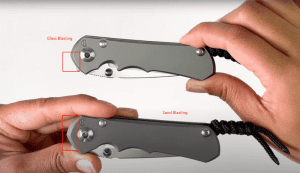
Glass Blast VS Sandblast
If you’re torn between bead blasting and sandblasting as a surface finishing option, this section will explain a few factors to consider.
- The Cycle Time for the Processes
Regarding the time needed for both processes, sandblasting is the better choice. It is faster, and sandblasting is the better choice if you need a process that can be completed quickly.
- The Type of Material Used
Bead blasting uses steel beads or fine glass, while sandblasting utilizes sand. In this case, bead blasting is the better choice. This is because sand contains silica, which has harmful respiratory effects when exposed to humans. However, glass and beads don’t have harmful consequences; hence, they are safer for use.
- The Abrasiveness of the Process
Sandblasting is the more abrasive process of the two, as it uses sand, an abrasive material. The abrasiveness of sand means it is harsher on the part’s surface and can cause changes in the part’s dimension. Hence, bead blasting is also the better choice here, considering abrasiveness, as it gives an optimum finish without damaging the part.
- Differences in the Finishing Appearances
In terms of finishing appearances, bead blasting is also the better choice. This is because it gives an optimum and uniform finish without damaging the part. Due to the abrasiveness of the sandblasted metal finish, it is better suited to stripping parts of rust, old paint, or scales. Hence, using it as a final finishing procedure could produce poor part aesthetics.
- Applications
As mentioned earlier, bead blasting can be used as a final surface finish for plastic, metal, rubber, or glass parts. On the other hand, sandblasting is more suited to removing impurities from the surface of parts.
Considering the factors highlighted, bead blasting is the better choice for both blasting processes. It gives a better finish and is gentler on the part’s surface.
Innovations and Trends in Bead Blasting and Sandblasting
Recently, innovation in technology and material science has made the bead and sandblasting finishes more precise and effective. In this context, prolean stays at the forefront of an evolving industry by embracing technological innovations and following trends.
- Automation in Surface Finishing
Automation is an important factor in enhancing efficiency and consistency in surface finishing. Robotic arms provide precision, computer-controlled blasting chambers offer more control over the process, and real-time monitoring systems ensure timely adjustments and maintenance. These technologies contribute to a higher quality finish and reduced labor costs while also minimizing the impact on the environment.
- Emerging Technologies in Blasting
Prolean is always looking to adopt emerging technologies that provide advantages in surface finishing. They have a table of emerging technologies that they have implemented, including wet blasting for reduced dust and enhanced finish, cryogenic blasting for environment-friendly and gentle cleaning, and laser cleaning for precision without abrasive materials.
Ready to give your machined parts the perfect finish they deserve? Get our top-tier bead blasting service! Superior quality, safety, and precision are just a click away. Opt for the best – choose our bead blasting service today.
Summing Up
We have discussed the principles, advantages, and limitations of bead blasting and sandblasting while showcasing the quality assurance, and safety protocols.
Understanding the nuances between bead blasting and sandblasting is imperative for anyone looking to achieve the best results for their machined parts.
While both processes harness the power of high-pressure equipment, the distinctions in the blast media, finishes, and safety concerns make bead blasting the more favorable option. It not only ensures a uniform and optimum finish but also prioritizes the operator’s safety and the machined part’s longevity.
FAQs
What distinguishes bead blasting from sandblasting?
Bead blasting utilizes glass beads and is gentler and suitable for fine finishes. Sandblasting employs sand or other abrasive materials for more aggressive cleaning and shaping.
Are there any industry-specific applications?
Sand and bead blasting caters to various industries, including automotive, maritime, aerospace, and restoration.
How do we ensure safety during sandblasting and bead blasting?
To ensure worker safety, follow strict safety protocols, including mandatory PPE, regular training, health monitoring, and well-ventilated workspaces.




Danke für den Leitfaden zum Sandstrahlen. Richtig es ist auch ein Abrasivstrahlen. Das Sandstrahlen mit dem Sandstahlgerät war mir geläufiger als das Perlenstrahlen.
It is great to hear that you get comprehensive knowledge of our post. Keep engaging with our blogs for follow-up contents